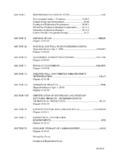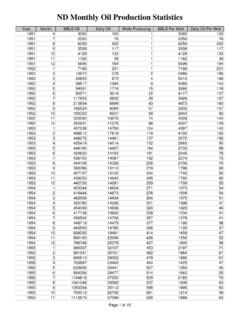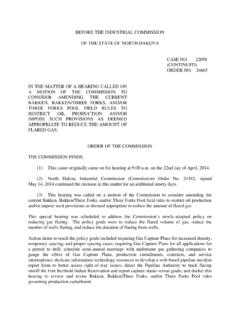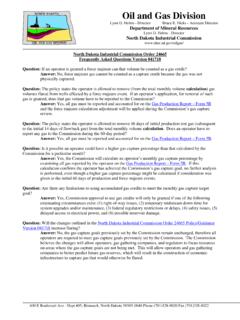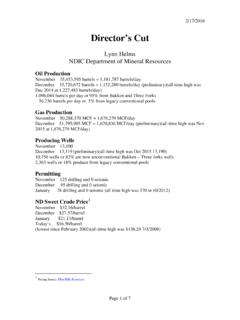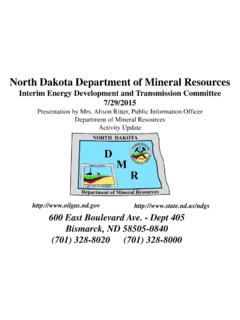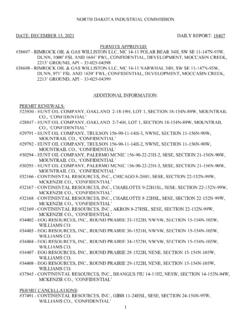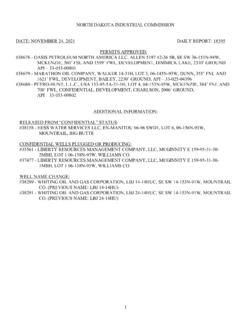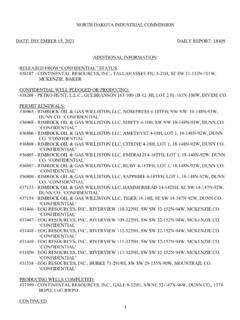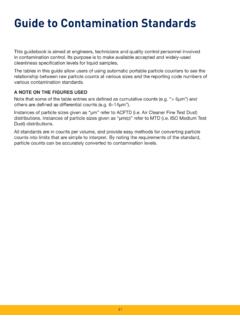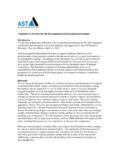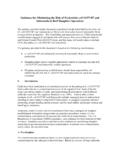Transcription of A GUIDE FOR REMEDIATION 20060502 FullSize
1 A GUIDE FOR REMEDIATION OF SALT/HYDROCARBON IMPACTED SOIL Distributed by: North Dakota Industrial Commission Department of Mineral Resources Bismarck, ND 58505-0840 Funded by the Oil and Gas Research Council Technical Author Len J. Gawel, BioRem Environmental Consultants 1601 Meadowbrook Dr. Ponca City, OK 74606 (580) 762-3805 REMEDIATION Philosophy Goal: Return the site to a state consistent with original land-use. Based on practical, accurate, and reproducible procedures. Use of select analyses, measurement of key indicators, recommended treatment, and a follow-up program. REMEDIATION process presented is continually being evaluated and improved.
2 Depending on various factors, plan on 3-4 year REMEDIATION duration. REMEDIATION requires patience. Acknowledgements Funding for the REMEDIATION GUIDE was provided by: 1. Oil and Gas Research Council 2. North Dakota Industrial Commission 3. Amerada Hess Corporation 4. BioRem Environmental Consultants In addition, the author appreciates the use of data derived from REMEDIATION projects conducted for Amerada Hess Corporation, Williston, ND, in the development of the REMEDIATION GUIDE . Disclaimer This REMEDIATION GUIDE is published to be used as an aid to the petroleum industry to remediate soil contaminated with salt water or petroleum hydrocarbons.
3 The author and contributors to the publication are not responsible for any consequences or results that occur upon implementing any recommendation stated in this GUIDE or stated in any oral presentation of this GUIDE . Tips For Use of the Field GUIDE : 1. Read and understand the various steps in the REMEDIATION GUIDE before using the field GUIDE . 2. Establish a record keeping system. Record all data, observations, and processes as soon as possible. 3. Maintain consistency in all tests and observations. Remember you are comparing data points to the control sample and to samples over time.
4 4. Always take the control sample first. 5. Accuracy and consistency will increase the rate of success. 6. The procedures used in this GUIDE are designed to remediate a site over a 3 to 4 year period. TABLE OF CONTENTS INTRODUCTION I. IMPACT OF SALT/HYDROCARBONS ON SOIL A. Impact of Salt on Soil B. Impact of Hydrocarbon on Soil C. Process of REMEDIATION II. SITE EVALUATION A. Measurement of the Site B. Type of Impact C. Area Topography D. Soil Surface E. Record Keeping III. SOIL SAMPLING A. Number and Location of Samples 1. Number of Samples 2. Site Uniformity B. Procedures for Taking Soil Samples IV.
5 PROCEDURE FOR CONDUCTING PHYSICAL EVALUATION OF SOIL A. Percent Aggregation B. Biological Activity C. Clay Content of Soil D. Depth of Topsoil V. SOIL ANALYTICAL TESTS A. Analytical Procedure to Determine the Electrical Conductivity (EC) of Soil B. Ribbon Test VI. SELECTION OF REMEDIATION AMENDMENTS A. Generic Amendments B. Site Preparation 1. Initial Preparation C. Addition of Amendments 1. Work Soil 2. Select Amendments 3. Incorporate Amendments D. REMEDIATION Amendments 1. Gypsum 2. HumexTM 3. Fertilizer 4. Sulfur E.
6 Adjustment of Amendments 1. Clay Content 2. Depth of Topsoil 3. pH F. Winter REMEDIATION G. Hydrocarbon/Salt Water Spill REMEDIATION VII. ALTERNATIVE REMEDIATION OPTIONS A. Soil Removal B. Manure Amendments VIII. REMEDIATION MONITORING AND CLOSURE A. Monitoring B. Site Closure IX. SUMMARY OF REMEDIATION GUIDE X. GLOSSARY OF TERMS XI. APPENDICES A. Environmental Equipment List B. Analytical Equipment and Amendment Suppliers C. References and Additional Resources D.
7 Record Keeping Form Example E. Soil Properties A. Physical Components of Soil 1. Inorganic Solids 2. Soil Triangle 3. Soil Clays 4. Organic Content of Soil 5. Sand and Silt B. Soil Profile C. Soil Aggregation D. Soil pH E. Soil Moisture F. Soil Chemistry A. Chemical Elements B. Dispersion in Soils C. Acidity/Alkalinity of Soils D. Amendments in REMEDIATION (1) INTRODUCTION The goal of this REMEDIATION GUIDE is to assist field personnel in restoring impacted soil to a state consistent with the original land use.
8 Sections I through IX of the GUIDE are intended as a field reference for REMEDIATION of salt and/or hydrocarbon impacted soils. Documentation of basic soil science used to develop the field GUIDE is included as appendices E (Soil Properties) and F (Soil Chemistry). This REMEDIATION GUIDE is based on practical, reproducible, and field-friendly procedures. The REMEDIATION method requires a limited amount of analytical data to formulate a REMEDIATION procedure. The analytical methods can be conducted in the field by a trained technician or in a local laboratory.
9 A nominal investment of time and equipment are required to perform these analyses and obtain accurate data. Steps detailing these analyses are outlined in the GUIDE . When the impact of a produced water or hydrocarbon discharge is examined, a number of critical factors can indicate the immediate and long-term impacts on soil structure and fertility. The use of and response to these factors are key to a successful REMEDIATION . Field experience has demonstrated a success rate greater than 80% when the methods in this GUIDE are properly followed. The REMEDIATION is based on a 3 to 4 year duration, with the exception of difficult problem sites, where only partial REMEDIATION may be obtained.
10 In these cases, additional remedial actions may be warranted. The REMEDIATION method in this GUIDE utilizes naturally occurring soil amendments, basic soil chemistry, and time to achieve success. Gypsum, the major REMEDIATION amendment, is a naturally occurring product in the earth s crust. Additionally, HumexTM, (also known as leonardite) is a secondary amendment that is also naturally-derived. Cost of the REMEDIATION process is an important part of the REMEDIATION plan; however, cost may vary significantly from area to area. Therefore, costs are not included in this GUIDE .
